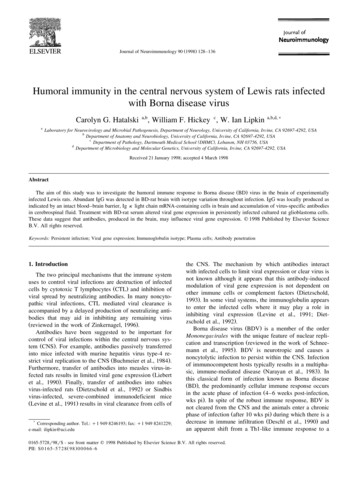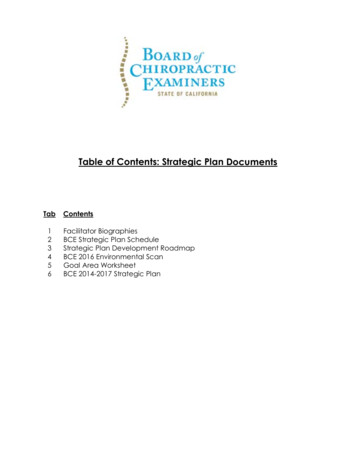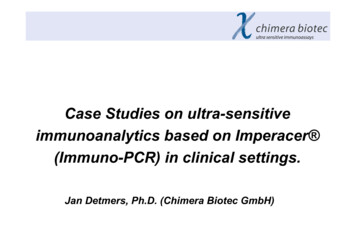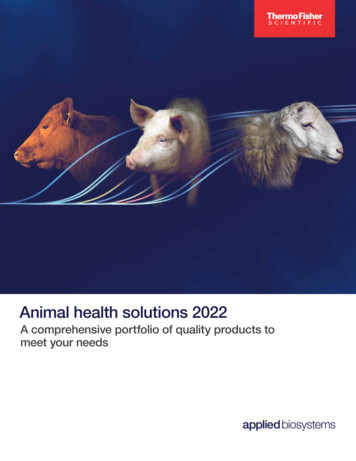
Transcription
Journal of Clinical Virology 37 (2006) 277–281Reverse ELISA for IgG and IgM antibodies to detectLassa virus infections in AfricaPetra Emmerich a , Corinna Thome-Bolduan a , Christian Drosten a , Stephan Gunther a ,Enikö Ban b , Imke Sawinsky a , Herbert Schmitz a, aDepartment of Virology, Bernhard-Nocht-Institute for Tropical Medicine, Bernhard-Nocht-Str. 74, D-20356 Hamburg, Germanyb Virusdiagnosztika C/II, Gyäli ut 2-6, Budapest 1097, HungaryReceived 12 May 2006; received in revised form 31 July 2006; accepted 18 August 2006AbstractBackground: Anti-Lassa antibodies are detected by indirect immunofluorescence assay (IFA) or by enzyme-immunoassay (ELISA). Bothmethods have problems to detect low amounts of specific antibodies.Objectives: We report here highly sensitive and specific reverse ELISAs to detect Lassa virus IgG and IgM antibodies. Due to the reversetechniques, serum samples could be applied at dilutions of 1:10 without increasing non-specific background reactions.Study design: For IgM antibody detection microtiter plates were coated with anti-IgM antibodies and for IgG antibody detection withrheumatoid factor (RF) (Sachers M, Emmerich P, Mohr H, Schmitz H. Simple detection of antibodies to different viruses using rheumatoidfactor and enzyme-labelled antigen (ELA). J Virol Methods 1985;10:99–110). In both assays a tissue culture antigen was used in combinationwith a labeled anti-Lassa monoclonal antibody (Hufert FT, Ludke W, Schmitz H. Epitope mapping of the Lassa virus nucleoprotein usingmonoclonal anti-nucleocapsid antibodies. Arch Virol 1989;106(3–4):201–12).Results: The reverse ELISA turned out to detect virus-specific IgG and IgM antibody in all 20 samples of West African patients collected2–8 weeks after onset of Lassa fever. Moreover, both IFA and reverse ELISA found IgG antibodies in 53 out of 643 samples of healthy WestAfricans (sensitivity of 100%). Six of the 643 samples were positive by reverse IgG ELISA only. Thus, the specificity compared to IIF was99.0%, but it may be even higher, because compared to IFA the IgG ELISA was clearly more sensitive in detecting low antibody titers.Conclusions: In Ghana 3% seropositives were found by IFA, but 4% by the reverse ELISA. The reverse ELISAs can be performed with highsensitivity and specificity under field conditions in Africa. 2006 Elsevier B.V. All rights reserved.Keywords: Reverse ELISA; Lassa IgG; IgM; Guinea; Ghana1. IntroductionLassa fever is highly endemic in Sierra Leone, Liberia andNigeria (Carey et al., 1972; Frame et al., 1970).During the first days after onset the clinical diagnosis ofLassa fever is difficult (McCormick et al., 1987a; Schmitzet al., 2002). Therefore, a laboratory diagnosis is needed,although this is difficult to achieve in West Africa withouthigh tech laboratories.Abbreviations: RF, rheumatoid factor; SA, soluble antigen; IFA, indirectimmunofluorecence assay Corresponding author. Tel.: 49 40 42818 460; fax: 49 40 42818 378.E-mail address: schmitz@bni.uni-hamburg.de (H. Schmitz).1386-6532/ – see front matter 2006 Elsevier B.V. All rights reserved.doi:10.1016/j.jcv.2006.08.015Acute Lassa fever is reliably diagnosed by virus isolation(Johnson et al., 1987; Jahrling et al., 1985a), by antigen detection (Bausch et al., 2000; Jahrling et al., 1985a,b) and by RTPCR (Demby et al., 1994; Drosten et al., 2002; Lunkenheimeret al., 1990). RT-PCR has turned out to be most sensitive.While RT-PCR and virus isolation pose technical problemsin West African field hospitals, antigen tests would be moreappropriate. But they are less sensitive and cannot detect lowamounts of virus (Bausch et al., 2000; Schmitz et al., 2002).As an alternative, antibodies tests may help to diagnose anacute Lassa virus infection. Thus, the presence of anti-LassaIgM antibody or a significant rise in titer of IgG antibodiescan prove an acute Lassa virus infection (Johnson et al., 1987;
278P. Emmerich et al. / Journal of Clinical Virology 37 (2006) 277–281McCormick et al., 1987b; Wulff and Lange, 1975). Besides,IgG antibodies to Lassa may be useful to study the epidemiology of Lassa fever infection (Lukashevich et al., 1993a;McCormick et al., 1987b).The best-studied method for antibody detection is IFA(Knobloch et al., 1980; Wulff and Lange, 1975). Since IFAhas been considerably observer dependent, we have improvedthe reading of slides by counterstaining the antigen inside thecells (Haas et al., 2003).As an alternative to IFA, indirect ELISA techniques havebeen published to detect IgG and/or IgM antibodies usingtissue culture (Bausch et al., 2000; Jahrling et al., 1985b;Niklasson et al., 1984) or by recombinant antigens (Barberet al., 1990; Gunther et al., 2001; ter Meulen et al., 1998).Anti-Lassa IgG antibodies were detected by indirect ELISAs.In contrast, IgM antibodies were also detected by a reversesystem using anti-IgM coated plates (Bausch et al., 2000;Jahrling et al., 1985b; Niklasson et al., 1984).Unfortunately, indirect ELISAs were not as sensitive asthe IFA in detecting IgG antibody (Bausch et al., 2000).This may be explained by the high serum dilutions of about1: 100, which have to be applied to avoid non-specific background staining. Moreover, in the case of recombinant proteins (Barber et al., 1990; Gunther et al., 2001; ter Meulenet al., 1998) the loss of virus-specific epitopes may also contribute to a reduced sensitivity.In contrast to indirect ELISA techniques, using labeledanti-immunoglobulin conjugates we have applied here areverse ELISA technique not only for IgM but also for IgGantibodies. To detect IgG antibodies, we have used a solidphase coated with rheumatoid factor (RF) (Sachers et al.,1985), where the amount of bound antibody is measuredusing either a directly labeled antigen (Schmitz et al., 1980)or an antigen that is detected with a labeled monoclonalantibody (Schmitz and Gras, 1986). Coating of the solidphase with anti-IgG antibodies, similar to anti-IgM coating,would be too insensitive. Instead, we selectively bind Lassaantigen–antibody complexes to RF during simultaneous incubation of the serum with Lassa antigen. The bound antigen isfinally detected using a biotinylated anti-Lassa mouse monoclonal antibody.The reverse ELISAs both for anti-Lassa IgG or IgM antibody detection allowed to apply the sera undiluted withoutincreased background staining. The sensitivity and specificityof the reverse IgG and IgM ELISAs were evaluated with samples of 20 acute Lassa fever patients and with more than 600serum samples of healthy West Africans.patients had had high fever and elevated aminotransferases.In the samples taken 2–30 weeks after onset, IgM and IgGantibodies to Lassa virus had be detected by IFA. In 11 ofthe 20 patients, of whom early samples were available, Lassavirus RNA was found by RT-PCR (Drosten et al., 2002).Moreover, upon ethical clearance, 643 samples were collected from adult, healthy subjects in West Africa (age 18–53years, m/f 1.2:1). Four hundred and thirty samples were fromGhana and 213 from Guinea. Serum samples of 200 healthyGerman blood donors were also tested.2.2. IFAIgG antibodies to Lassa virus were detected using acetonefixed Vero cells infected with Lassa virus strain Josiah (Wulffand Lange, 1975). Cultivation of the viruses was carried outin a BSL 4 laboratory. Our own data have consistently shownthat from acetone-fixed Lassa virus infected cells no viruscan be cultivated upon inoculation of Vero E6 cells. Serumsamples were tested in two-fold steps starting at a dilution of1:20. Cell smears were routinely counterstained with an antiLassa nucleocapsid monoclonal antibody 2F1 (Hufert et al.,1989) using Rhodamine-anti-mouse as secondary antibody(Haas et al., 2003). Also cell smears of Vero E6 cells infectedwith Lymphocytic Choriomenigitis virus (strain AmstrongM20869) and with Mopeia virus (strain 800150, M33879)were prepared.2.3. Preparation of soluble antigen (SA)SA was obtained by sonification of Lassa virus (Josiahstrain) infected Vero E6 cells of one bottle (50 ml) in 10 mlPBS containing 0.3% detergent (NP 40, Sigma–Aldrich,Munich, Germany). Cell debris was removed by low speedcentrifugation (5000 g, 20 min). The SA could be storedlyophilized at room temperature and was additionally inactivated by gamma irradiation (24 kGray) (Bausch et al., 2000).2.4. Monoclonal antibodyMonoclonal antibody 2F1 (Hufert et al., 1989) reacts withthe nucleoprotein of several Lassa viruses (Josiah isolate ofSierra Leone, AV of Ivory Coast, CSF of Nigeria; Gunther andLenz, 2004) by IFA. It does not cross react with Mopeia virusor LCMV. It was purified to 1 mg/ml and labeled with NHSbiotin (Sigma–Aldrich) according to standard procedures.2.5. Antigen titration2. Material and methods2.1. Serum samplesFrom studies in Nigeria (Omilabu et al., 2005), Liberia,Sierra Leone and Guinea late serum samples of 20 Lassafever survivors were available. At onset of the disease allThe Sandwich ELISA has been described in more detailearlier (Schmitz and Wolff, 1986). The antigen was incubatedon the antibody (2F1) coated plates over night at 4 C and wasdetected using the biotinylated antibody 2F1 at a dilutionof 1:4000 followed by strepavidine-peroxidase (see reverseELISA).
P. Emmerich et al. / Journal of Clinical Virology 37 (2006) 277–2812.6. Reverse ELISA for IgM and IgG antibodiesAnti-IgM coated microtiter plates were used to bind theIgM fraction of the serum samples (50 l aliquots), diluted1:10 in PBS 0.5% Tween in two-fold steps. After incubation for 1 h and washing with PBS 0.5% Tween, SA wasemployed for another 2 h at 20 C.For IgG antibody detection, 25 l SA were mixed withan equal volume of the serum samples, which were dilutedin two-fold steps starting with 1:5 (dilution in SA: 1:10) inPBS 0.5% Tween and incubated over night at room temperature on RF-coated microtiter plates (Medac, Hamburg,Germany).The following steps were identical for both reverse IgGand IgM ELISAs:After washing, the bound antigen was detected by labeledmonoclonal antibody 2F1, applied for 1 h at a dilution of1:4000. After washing, streptavidin-peroxidase conjugate(1:8000; Sigma–Aldrich) was added for 30 min.After washing the test was stained with TMB (Sigma–Aldrich). The reaction was stopped after 10 min by addition of 2 M sulfuric acid. The absorbance was measured at450 nm. The cut off OD for positive results was calculatedas mean OD of the negative samples 3 standard deviations(s).2.7. Improving test conditionsUpon infection of the Vero cells with a PFU of 0.01 andincubation at 37 C for 4 days, SA titers of 1: 256 weremeasured by the sandwich ELISA.To optimize the reverse IgG ELISA, the positive/negative(P/N) ratios for different dilutions of the SA and the labeledmonoclonal antibody were determined. A confirmed antiLassa positive serum at a dilution of 1:1000 (IgG antibodytiter in IFA 1:5120) and a negative serum samples diluted1:10 were applied. Highest P/N ratios were obtained with theundiluted SA (titer 1: 256) and a dilution 1:4000 of the mon-279Table 1Comparison of IFA with the reverse IgG Elisa using 643 serum samples ofhealthy donors of West Africa (Guinea, Ghana)IIFPositiveNegativeIgG ElisaPositiveNegative5360584Sensitivity 100%Specificity 99%oclonal antibody. Besides, the optimum incubation period ofthe SA-human antibody complexes was over night at 4 C(Fig. 1).3. Results3.1. Sensitivity and specificity of the IgG ELISAIn 20 patients with recent Lassa fever IgM and IgG antibodies to Lassa virus had been found by IFA. The IgG IFAtiters ranged from 1:320 to 10240. Using the reverse IgGELISA, the same serum samples showed even higher antibody titers (range 1280–20480). Two hundred serum samplesof German blood donors, were negative both by IFA andreverse IgG ELISA (mean OD 3s 0.05).Six hundred and forty three serum samples of healthyadults had been collected in West Africa (Guinea, Ghana).Fifty three out of the 643 serum samples showed IgG antibodies by IFA (Table 1). Likewise, the IgG ELISA detectedall 53 samples, but 6 additional samples were positive byIgG ELISA only. Using IFA, the six sera did not have antibodies to Lymphocytic Choriomeningitis- and to Mopeiavirus. The discrepant ELISA titers were rather low (between1:20 and 1:80). Therefore, compared to IFA, the reverse IgGELISA had a sensitivity of 100% and a specificity of 99%(predictive value positive: 89%, predictive value negative:100%). A close correlation between the IFA and the reverseELISA titers was found (correlation coefficient r 0.9). Linear regression shows that titers detected by IgG ELISAexceed that obtained by IFA by about four-fold (Fig. 2A). Butlow titers of 1: 80 in the IgG ELISA might not be detectableat a dilution of 1:20 by IFA. To test this possibility, three positive serum samples with a titer of 1:320 in IFA and 1:1280by reverse IgG ELISA, were diluted 1:20 in negative serum.These mixtures should now have a titer of 1:64 in the ELISAand 1:16 by IFA. In fact, the residual anti-Lassa antibodieswere not longer demonstrable by IFA using the mixtures ata dilution of 1:20, while the IgG ELISA detected a residualtiter of 1:80 in all three mixtures.3.2. Testing the reverse IgG ELISA in the fieldFig. 1. Different incubation times of the antigen–antibody complexes onthe RF-coated plates. Positive serum (titer 1:5120) and negative serum wereused at a dilution of 1:1000 and 1:10, respectively. A maximum P/N ratio ofabout 20-fold was obtained after 12–24 h.Using IFA, the prevalence of antibody positives in Guineawas 18.8% (40 of 213 samples) and in Ghana 3% (13 of 430samples). The prevalence data would be somewhat higher(4% for Ghana), if the data of the ELISA would be taken intoaccount.
280P. Emmerich et al. / Journal of Clinical Virology 37 (2006) 277–281Fig. 2. (A) Correlation between IgG antibody titers detected by IFA (xaxis) and IgG Elisa (y-axis) in 53 serum samples of healthy West Africanblood donors. Correlation coefficient r 0.96. (B) Correlation between IgMantibody titers detected by IFA (x-axis) and IgM Elisa (y-axis) in 20 serumsamples of patients with recent Lassa fever. Correlation coefficient r 0.87.On an average, Elisa titers exceed IIF titers by about four-fold as indicatedby the linear regression lines. (Numbers indicate overlapping datum dots.)3.3. Reverse IgM ELISAIn contrast to the reverse IgG ELISA, an incubation timeof the sera of 1 h was sufficient.Three hundred samples (including those 53 sampleswith IgG antibodies) of healthy people from Guinea (100)and Ghana (200) were negative both by IFA and reverseIgM ELISA. Furthermore, 100 samples of the Germanblood donors turned out IgM antibody negative with bothtests. The reverse IgM ELISA showed the same lowbackground staining (mean OD 3s 0.05) as the IgGELISA.The 20 serum samples of patients with IgM antibodiesby IFA were also positive using the reverse IgM ELISA.The titers in the IgM ELISA ranged from 1.80 to 1:20480and exceeded that obtained by IFA by four- to eight-fold(Fig. 2B).4. DiscussionConsidering the high frequency of acute Lassa fever casesin West Africa (Lukashevich et al., 1993b; McCormick et al.,1987b; Schmitz et al., 1981), there is an urgent need for sim-ple and reliable laboratory diagnostics. Antibody tests canhelp to confirm a Lassa fever suspect during an outbreak ofhemorrhagic fever in West Africa. A positive IgM antibodyresult may give rise to isolation measures. The higher sensitivity of our reverse IgM ELISA compared to IFA suggeststhat it may detect specific IgM antibody early after onset offever.The reverse technique also improved the sensitivity ofIgG antibody detection. Mixtures of positive and negativesera with a final titer of 1:80 by reverse ELISA were nolonger detected by IFA. Since a continuous decline of IgGantibodies to Lassa virus has been reported in West Africans(McCormick et al., 1987b; ter Meulen et al., 2000), assaysdetecting low IgG antibody concentrations would be of valuefor antibody prevalence studies.The high sensitivity of both reverse ELISAs may in part bedue to the low background staining with an OD of 0.05 fornegative samples. In contrast to indirect ELISAs or IFA, usinglabeled anti-globulin antibodies the reverse technique measures the amount of bound antibody via antigen. Therefore,it will not detect traces of non-specifically bound IgG or IgMimmunoglobulin and parallel testing with a control antigenis not required. At least all 53 6 ELISA positive samples(Table 1) showed completely negative results (OD 0.05)using a control antigen prepared of uninfected Vero C6 cells.Therefore, the control antigen could not provide additionalinformation on false positive results.The high specificity of the reverse IgG ELISA rests ontwo successive immune reactions: first, the anti-Lassa antibody has to find its counterpart, the SA, before a conformational change of Fc-portion will occur, which in turn isrecognized by the RF (Sachers et al., 1985). Moreover, theapplication of a biotinylated monoclonal antibody to Lassavirus nucleoprotein contributes to the specificity of bothtests. This monoclonal was chosen because the nucleoprotein induces a stronger immune response in humans than theLassa virus glycoproteins (Barber et al., 1990; Hufert et al.,1989).On the other hand, the long incubation period of theimmune complexes may be problematic for a rapid diagnosis. But in acute Lassa fever, the less time consuming reverseIgM test has to be applied in the first place (Bausch et al.,2000) while the IgG ELISA may preferentially be used forconfirmation.Moreover, due to preformed immune complexes or RF inserum samples, the reverse IgG ELISA might give rise to falsenegative results. However, such interference has not beenobserved with similar reverse ELISAs for Cytomegalovirus(Schmitz et al., 1980) or flaviviruses (Sachers et al., 1985).Besides, compared to IFA, the reverse IgG ELISA did notproduce any false negative results. Nevertheless, an initialdilution of 1:10 may be advisable to dilute possible immunecomplexes.Both reverse ELISAs are currently applied in a field laboratory in Nigeria, where they may help to advance ourunderstanding of Lassa virus infections.
P. Emmerich et al. / Journal of Clinical Virology 37 (2006) 277–281AcknowledgementsWe would like to thank Dr. H. Sudek, Dr. S. Schmiedeland Dr. Sunday Omilabu for their work in Africa on Lassafever patients and C. Benthien, A. Parczany-Hartmann andG. Riedorf for technical assistance. This study was in partsupported by Bundesamt für Wehrtechnik und Beschaffung(Grant 911500TP2).ReferencesBarber GN, Clegg JC, Lloyd G. Expression of the Lassa virus nucleocapsidprotein in insect cells infected with a recombinant baculovirus: application to diagnostic assays for Lassa virus infection. J Gen Virol 1990;71(Pt1):19–28.Bausch DG, Rollin PE, Demby AH, Coulibaly M, Kanu J, Conteh AS, et al.Diagnosis and clinical virology of Lassa fever as evaluated by enzymelinked immunosorbent assay, indirect fluorescent-antibody test, and virusisolation. J Clin Microbiol 2000;38(7):2670–7.Carey DE, Kemp GE, White HA, Pinneo L, Addy RF, Fom AL, et al. Lassafever. Epidemiological aspects of the 1970 epidemic, Jos, Nigeria. TransR Soc Trop Med Hyg 1972;66(3):402–8.Demby AH, Chamberlain J, Brown DW, Clegg CS. Early diagnosis ofLassa fever by reverse transcription-PCR. J Clin Microbiol 1994;32(12):2898–903.Drosten C, Gottig S, Schilling S, Asper M, Panning M, Schmitz H, etal. Rapid detection and quantification of RNA of Ebola and Marburg viruses, Lassa virus, Crimean-Congo hemorrhagic fever virus,Rift Valley fever virus, dengue virus, and yellow fever virus by realtime reverse transcription-PCR. J Clin Microbiol 2002;40(7):2323–30.Frame JD, Baldwin JM, Gocke DJ, Troup JM. Lassa fever, a new virusdisease of man from West Africa. I. Clinical description and pathologicalfindings. Am J Trop Med Hyg 1970;19(4):670–6.Gunther S, Kuhle O, Rehder D, Odaibo GN, Olaleye DO, Emmerich P, etal. Antibodies to Lassa virus Z protein and nucleoprotein co-occur inhuman sera from Lassa fever endemic regions. Med Microbiol Immunol(Berl) 2001;189(4):225–9.Gunther S, Lenz O. Lassa virus. Crit Rev Clin Lab Sci 2004;41(4):339–90.Haas WH, Breuer T, Pfaff G, Schmitz H, Kohler P, Asper M, et al. ImportedLassa fever in Germany: surveillance and management of contact persons. Clin Infect Dis 2003;36(10):1254–8.Hufert FT, Ludke W, Schmitz H. Epitope mapping of the Lassa virus nucleoprotein using monoclonal anti-nucleocapsid antibodies. Arch Virol1989;106(3–4):201–12.Jahrling PB, Frame JD, Smith SB, Monson MH. Endemic Lassa fever inLiberia. III. Characterization of Lassa virus isolates. Trans R Soc TropMed Hyg 1985a;79(3):374–9.Jahrling PB, Niklasson BS, McCormick JB. Early diagnosis of humanLassa fever by ELISA detection of antigen and antibody. Lancet1985b;1(8423):250–2.281Johnson KM, McCormick JB, Webb PA, Smith ES, Elliott LH, King IJ.Clinical virology of Lassa fever in hospitalized patients. J Infect Dis1987;155(3):456–64.Knobloch J, McCormick JB, Webb PA, Dietrich M, Schumacher HH, Dennis E. Clinical observations in 42 patients with Lassa fever. TropenmedParasitol 1980;31(4):389–98.Lukashevich IS, Lukashevich VD, Vladyko AS, Diallo MS, Ba MA, SillaA. Serological evidence of Lassa virus circulation in the Republic ofGuinea. Vopr Virusol 1993a;38(1):24–8.Lukashevich LS, Clegg JC, Sidibe K. Lassa virus activity in Guinea:distribution of human antiviral antibody defined using enzyme-linkedimmunosorbent assay with recombinant antigen. J Med Virol 1993b;40(3):210–7.Lunkenheimer K, Hufert FT, Schmitz H. Detection of Lassa virus RNA inspecimens from patients with Lassa fever by using the polymerase chainreaction. J Clin Microbiol 1990;28(12):2689–92.McCormick JB, King IJ, Webb PA, Johnson KM, O’Sullivan R, Smith ES,et al. A case-control study of the clinical diagnosis and course of Lassafever. J Infect Dis 1987a;155(3):445–55.McCormick JB, Webb PA, Krebs JW, Johnson KM, Smith ES. A prospective study of the epidemiology and ecology of Lassa fever. J Infect Dis1987b;155(3):437–44.Niklasson BS, Jahrling PB, Peters CJ. Detection of Lassa virus antigensand Lassa virus-specific immunoglobulins G and M by enzyme-linkedimmunosorbent assay. J Clin Microbiol 1984;20(2):239–44.Omilabu SA, Badaru SO, Okokhere P, Asogun D, Drosten C, EmmerichP, et al. Lassa fever, Nigeria, 2003 and 2004. Emerg Infect Dis2005;11(10):1642–4.Sachers M, Emmerich P, Mohr H, Schmitz H. Simple detection of antibodiesto different viruses using rheumatoid factor and enzyme-labelled antigen(ELA). J Virol Methods 1985;10:99–110.Schmitz H, Gras F. Specific enzyme immunoassay for the detection of antibody to HTLV-III using rheumatoid factor-coated plates. J ImmunolMethods 1986;88:115–20.Schmitz H, Knobloch J, Dietrich M. Prevalence of antibodies to Lassa-virusin Liberia. Tropenmed Parasitol 1981;32:200–1.Schmitz H, Kohler B, Laue T, Drosten C, Veldkamp PJ, Gunther S, et al.Monitoring of clinical and laboratory data in two cases of imported Lassafever. Microbes Infect 2002;4(1):43–50.Schmitz H, von Deimling U, Flehmig B. Detection of IgM antibodies toCytomegalovirus (CMV) using an enzyme-labelled antigen (ELA). JGen Virol 1980;50:59–68.Schmitz H, Wolff C. Use of monoclonal antibody for the detection of antibody and antigen in patients with Lassa fever. Med Microbiol Immunol1986;175:181–2.ter Meulen J, Badusche M, Kuhnt K, Doetze A, Satoguina J, Marti T, etal. Characterization of human CD4( ) T-cell clones recognizing conserved and variable epitopes of the lassa virus nucleoprotein. J Virol2000;74(5):2186–92.ter Meulen J, Koulemou K, Wittekindt T, Windisch K, Strigl S, Conde S, etal. Detection of Lassa virus antinucleoprotein immunoglobulin G (IgG)and IgM antibodies by a simple recombinant immunoblot assay for fielduse. J Clin Microbiol 1998;36(11):3143–8.Wulff H, Lange JV. Indirect immunofluorescence for the diagnosis of Lassafever infection. Bull World Health Organ 1975;52(4–6):429–36.
Journal of Clinical Virology 37 (2006) 277-281 Reverse ELISA for IgG and IgM antibodies to detect Lassa virus infections in Africa Petra Emmericha, Corinna Thome-Bolduana, Christian Drostena, Stephan Gunthera, Eniko Ban b, Imke Sawinskya, Herbert Schmitza, a Department of Virology, Bernhard-Nocht-Institute for Tropical Medicine, Bernhard-Nocht-Str. 74, D-20356 Hamburg, Germany










